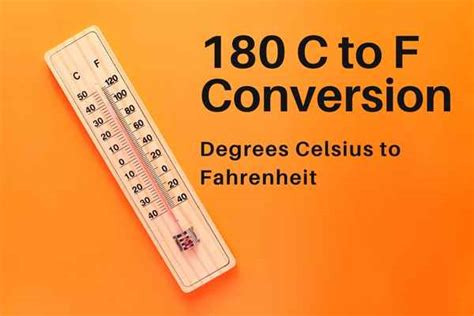How Many Degrees Fahrenheit Is 180 C
Kalali
Apr 05, 2025 · 4 min read

Table of Contents
How Many Degrees Fahrenheit is 180°C? A Comprehensive Guide to Temperature Conversions
Understanding temperature conversions is crucial in various fields, from cooking and baking to scientific research and meteorology. Often, we need to quickly and accurately convert between Celsius (°C) and Fahrenheit (°F). This article delves into the conversion of 180°C to Fahrenheit, providing a detailed explanation of the process, along with practical applications and further exploration of temperature scales.
Understanding the Celsius and Fahrenheit Scales
Before jumping into the conversion, let's briefly review the two temperature scales:
-
Celsius (°C): Also known as the centigrade scale, Celsius is widely used globally and is based on the freezing and boiling points of water at standard atmospheric pressure. Water freezes at 0°C and boils at 100°C.
-
Fahrenheit (°F): Primarily used in the United States, Fahrenheit defines the freezing point of water as 32°F and the boiling point as 212°F.
Converting 180°C to Fahrenheit: The Formula
The conversion from Celsius to Fahrenheit employs a simple yet effective formula:
°F = (°C × 9/5) + 32
Let's apply this formula to convert 180°C to Fahrenheit:
°F = (180 × 9/5) + 32
°F = (180 × 1.8) + 32
°F = 324 + 32
°F = 356
Therefore, 180°C is equal to 356°F.
Practical Applications of Temperature Conversions
The ability to convert between Celsius and Fahrenheit has numerous real-world applications:
Cooking and Baking:
Precise temperature control is paramount in cooking and baking. Recipes often provide temperatures in either Celsius or Fahrenheit, requiring accurate conversion for successful results. Imagine trying to bake a cake using the wrong temperature – the outcome could be disastrous!
Scientific Research:
Scientists frequently work with various temperature scales. Converting between Celsius and Fahrenheit is essential for data analysis, experimental design, and ensuring consistency across different research projects. This is critical in fields like chemistry, physics, and biology where precise temperature measurements are essential for accurate results.
Meteorology:
Weather reports often use either Celsius or Fahrenheit. Understanding the conversion allows for easy comprehension of weather information regardless of the scale used. This knowledge is crucial for planning outdoor activities, understanding weather warnings, and assessing the impact of temperature fluctuations on various systems.
Engineering and Manufacturing:
Many industrial processes require precise temperature control. Converting between Celsius and Fahrenheit ensures consistency in manufacturing processes and prevents errors in the production of various materials and products. For example, materials science relies heavily on accurate temperature measurements during manufacturing processes.
Healthcare:
In healthcare, accurate temperature measurements are crucial for monitoring patients and administering treatments effectively. Understanding temperature conversions helps ensure the consistent application of medical protocols and effective patient care. Body temperature, for example, can be measured in either Celsius or Fahrenheit and understanding the conversion between the two is critical.
Beyond the Basics: Understanding Temperature Scales
While Celsius and Fahrenheit are the most commonly used scales, other scales exist, each with its own specific applications:
-
Kelvin (K): This absolute temperature scale is primarily used in scientific research. Zero Kelvin (0 K) represents absolute zero, the theoretical lowest possible temperature. This scale is closely related to Celsius, where K = °C + 273.15.
-
Rankine (°R): Similar to Kelvin, Rankine is an absolute temperature scale, but it's based on Fahrenheit. °R = °F + 459.67.
Understanding the relationship between these different scales provides a comprehensive perspective on temperature measurement and its applications in various fields.
Troubleshooting and Common Mistakes
When converting between Celsius and Fahrenheit, a common mistake is forgetting the addition of 32 to the result after multiplying by 9/5. Always double-check your calculations to ensure accuracy.
Using a calculator can help avoid manual calculation errors. Many online converters are available, providing instant conversions between Celsius and Fahrenheit and other temperature scales. However, understanding the underlying formula is still crucial for comprehension and problem-solving.
Expanding Knowledge: Further Exploration of Temperature Conversion
For a deeper understanding, explore the history of these temperature scales and the scientists behind their development. Investigating their applications in specific industries, such as food science or aerospace engineering, can broaden your understanding of the significance of accurate temperature measurement.
Conclusion: Mastering Temperature Conversions
Mastering the conversion between Celsius and Fahrenheit is a valuable skill applicable across various disciplines. The formula is straightforward, but accuracy is paramount. Understanding the different temperature scales and their applications enhances your overall understanding of temperature measurement and its influence on our daily lives and scientific endeavors. The conversion of 180°C to 356°F provides a practical example of this essential skill, emphasizing the importance of precision and understanding in working with temperature scales. By consistently applying the formula and understanding the underlying concepts, you can confidently tackle temperature conversions and use this knowledge to excel in your endeavors.
Latest Posts
Latest Posts
-
How Many Centimeters Are In 64 Inches
Apr 05, 2025
-
Which Statement Regarding Cardiac Muscle Structure Is Accurate
Apr 05, 2025
-
Cuales Son Los Productos De La Fotosintesis
Apr 05, 2025
-
How Many Cups In 8 Oz Sour Cream
Apr 05, 2025
-
20 Is What Percent Of 30
Apr 05, 2025
Related Post
Thank you for visiting our website which covers about How Many Degrees Fahrenheit Is 180 C . We hope the information provided has been useful to you. Feel free to contact us if you have any questions or need further assistance. See you next time and don't miss to bookmark.
